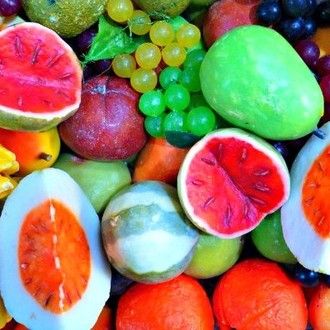
While other countries are freezing under the snow, sunlight is beaming over Mauritius. It’s summer! Summer means an abundance of fruits in Mauritius. However, we will not be talking about those which are readily available throughout the island at the moment, like pineapples, watermelons, litchis or mangoes. We will mention some fruits which our elders used to relish but that cannot really be found on the island since some time.
a. The June Plum
This one is known as “friciter” by Mauritians. It looks somewhat like a pawpaw but belongs to the family of mangoes. Sweet yet sour to taste, it is known to “arranz labouss”. This expression is not to be understood literally. It means that the June Plum allows one to be able to get the taste of food again, following a flu for instance. Mauritians, particularly the elders, would go drool over some June Plum pickle.
b. The Bilimbi and the Otaheite gooseberry
There hardly is a Mauritian eating this fruit nowadays. Maybe it is because it is hard to cultivate. The Mauritian will mention two types of bilimbi: the “long” one and the “round” one. However, the “round” one is not a bilimbi at all; it is an Otaheite gooseberry. The “long” bilimbi looks like a gherkin and belongs to the family of the star fruit. Pickled “long” bilimbi or Otaheite gooseberry makes a great condiment to biryani.
c. The Star Fruit
This fruit, as you would have guessed, is star-shaped. Its thin skin becomes a beautiful yellow shade when it is ripe. It can be bitter and honey helps make it delicious. The Star Fruit was not famous in Europe before 2016. However, one should eat this fruit in moderation. It can cause digestive problems and even heart failure, leading to death.
d. The Japanese Medlar (Bibasse)
Commonly called Bibasse in Mauritius, the Japanese Medlar can no longer be found in markets. There are still some trees in forests on the island. Reunion Island meanwhile is spoilt by their presence. The bibasse can be eaten raw. The toxicity of its seed has given rise to an expression which describes someone who is unbearable: “graine de bibasse” (bibasse seed).
e. The Soursop
The soursop tree has been on our island for more than two centuries. Its fruit is called “coronssol” by Mauritians. It has a prickly skin, the appearance of which might deter you from eating it. However, it contains great quantities of vitamins B1 and B2, potassium and phosphorus. It has a flowery taste, slightly like that of the mango or the litchi’s. The soursop would make a unique sorbet.
f. The Kaffir Lime (Mauritian Papeda)
This rough-skinned citrus fruit can be mistaken for a normal lime once it is cut open. With an aroma of ginger and lemongrass, its zest is mainly used to give fragrance to dishes. In addition to its good smell, the Kaffir Lime also boosts the immune system. It is full of calcium. A small amount is enough, since it is very bitter.
g. The Bullock’s Heart
Of a reddish colour when it is ripe, the bullock’s heart, also known as cachiman, contains a white pulp. Its name is derived from its appearance. A close relative of the soursop, it still has a distinct taste. The bullock’s heart sorbet, for instance, provides a good intake of fibre. It also relieves abscesses and helps in digestion.
